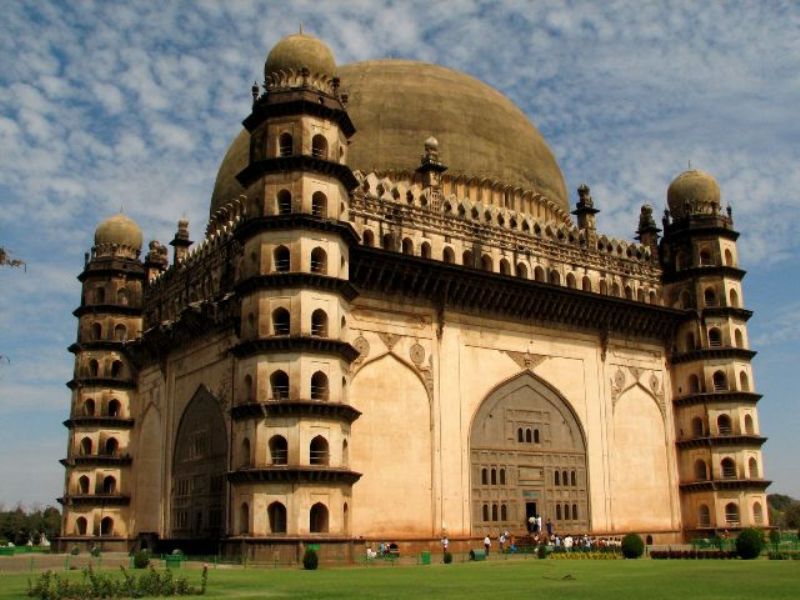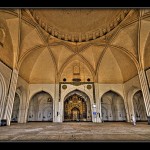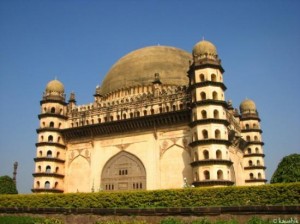 The beautiful city of Bijapur is located in Karnataka in South India. It is famous for the many historic marvels that dot the city. The history of the city dates back to the 11th century when it was founded by the Chalukya dynasty. They referred to it as Vijayapura.
The beautiful city of Bijapur is located in Karnataka in South India. It is famous for the many historic marvels that dot the city. The history of the city dates back to the 11th century when it was founded by the Chalukya dynasty. They referred to it as Vijayapura.
It was since the 14th century that the city was being called Vijapur or Bijapur when it came under the Bahamani sultanate of Gulbarga. The city was taken over by the Adil shah dynasty in the 15th century. Much of the city’s greatness belongs to the monuments that were constructed during this period. After India’s independence the place became part of the Bombay state but it was restored to Mysore in 1956.
The city comprises people of both Aryan and Dravidian descent. Most of the city’s population is Hindu Lingayat. There are very few Christian and Muslim communities in the region.
Bijapur is a city as well as headquarters of the Bijapur district situated in the north-western part of Karnataka. It is situated about 530 km from the capital city Bangalore. This town is famous for its monuments built during the Dynasty of Adil Shahi, including the renowned Gol Gumbaz, along with ancient Islamic architecture and cultural value.
Solapur of Maharashtra surrounds the district of Bijapur on the northern side and Sangli district lies on the north-western side. The other districts bordering the regions are Belgaum on the western side and Bagalkote on the southern side.
History
 The Bijapur city in Karnataka is a historical town that boats of rich heritage and culture. The history of Bijapur goes to the times of Kalyan Chalukya who ruled here during the 11th and 12th century. During this time the city was known as Vijayapura. In later part of the 13th century, the city like the rest of the India came under the rule of the Khilji Sultanate of Delhi.
The Bijapur city in Karnataka is a historical town that boats of rich heritage and culture. The history of Bijapur goes to the times of Kalyan Chalukya who ruled here during the 11th and 12th century. During this time the city was known as Vijayapura. In later part of the 13th century, the city like the rest of the India came under the rule of the Khilji Sultanate of Delhi.
The city came under the ruling of the Bahmani Sultans of Gulbarga in the year 1347 and it was then that the time was referred as ‘Vijaypur’ which later got malformed into ‘Bijapur’. Further in the year 1518, the Bahmani sultans splintered in to five and were known as the Deccan Sultans. Bijapur came into the hands of King Adil Shah Dynasty and was led by Yusuf Adil Shah. Most of the monuments that adorn Bijapur today were built during his reign.
Aurangzeb captured the land of Bijapur in 1686, marking the end of the rule of Adil Shah Dynasty. However, British gained control of Bijapur along with Satara in 1848, after a fierce battle between Peshawa and the British. It remained so till independence, when it was declared a part of Bombay state. It the year 1956, the city of Bijapur was reassigned to the Mysore state which later came to known as Karnataka.
Place of interest
Gol Gumbaz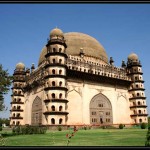
Second Largest DomeBuilt in 1659, is the mausoleum of Mohammed Adil Shah and some members of his family. Its vast dome is said to be the Second Largest Dome, unsupported by pillars, in the world, after St. Peter’s in the Vatican City of Rome.
It is constructed in such a way that even a pin drop can be heard distinctly from across a space of 38 m, in the Whispering Gallery. The acoustics here are such that any sound made is said to be repeated 10 times over. In the surrounding ornamental gardens is an archeological museum.
Basanta Vana
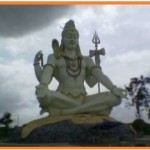 Second tallest idol of Shiva in IndiaThis 85 feet cement and steel idol at Rambapur village 3Kms from City of Bijapur on the Ukkali road was unveiled on Feb 26th 2006 — the auspicious day of Shivarathri.
Second tallest idol of Shiva in IndiaThis 85 feet cement and steel idol at Rambapur village 3Kms from City of Bijapur on the Ukkali road was unveiled on Feb 26th 2006 — the auspicious day of Shivarathri.
A small idol of Shivalinga is installed beneath the big statue. “Shiva Charite” will also be inscribed in Kannada on the inner walls of the temple to help the devotees learn the mythological stories related to Lord Shiva.
This is one of the biggest mosque standing tall since 450 years.Jamai Masjid is considered one of the finest mosque in India, is a finely proportioned mosque that was constructed by Ali Adil Shah I (1557-80). It sprawls over an area of about 1,16,300sq.m and has graceful arches, a fine dome and a large inner courtyard with room for 2250 worshippers, spaces for them marked out in black squares on the polished floor. The Mosque’s sacred alcove has the Koran intricately painted on it with letters of gold.
Malik E-Maidan
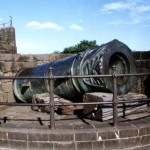 The largest medieval cannon in the world(The Monarch of the Plains) the largest medieval cannon in the world. Being 4 m long, 1,5 m in diameter and weighing 55 tons, this gun was brought back from Ahmadnagar in the 17th century as a trophy of war by 400 oxen, 10 elephants and tens of men.
The largest medieval cannon in the world(The Monarch of the Plains) the largest medieval cannon in the world. Being 4 m long, 1,5 m in diameter and weighing 55 tons, this gun was brought back from Ahmadnagar in the 17th century as a trophy of war by 400 oxen, 10 elephants and tens of men.
Kudala Sangama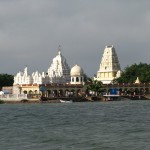
Kudala Sangama is an important center of pilgrimage for people of the Lingayat faith. It is located about 15 km from the Almatti Dam in Bagalkot district of Karnataka state. The Krishna river and Ghataprabha river merge here and flow east towards Srisaila (another pilgrim center) in state of Andhra Pradesh. The Aikya Mantapa or the holy Samadhi of Basavanna, the founder of the Lingayat faith along with Linga, which is believed to be self-born (Swayambhu), is situated here.
Almatti Dam
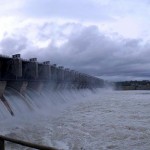 Length: 1565.15 m | Height: 52.25 m | Construction cost : Rs. 520 croresThe Almatti Dam is a Dam project on the Krishna River in North Karnataka, India. The annual energy design is 713 million units. It was completed in July 2005.
Length: 1565.15 m | Height: 52.25 m | Construction cost : Rs. 520 croresThe Almatti Dam is a Dam project on the Krishna River in North Karnataka, India. The annual energy design is 713 million units. It was completed in July 2005.
Almatti dam is the main reservoir of the Upper Krishna project, an irrigation project. The 290 MW power project is located on the right toe of Almatti Dam. The Power House has 5 units of 55 MW each and 1 unit of 15 MW. The turbines are vertical kaplan. The annual design energy is 713 Million Units
Gajanan Temple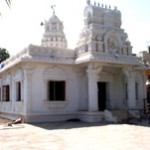
A modern temple dedicated to the elephant headed god – Ganesha.This mansion was constructed by Ali Adil Shah I in 1561. It served as a royal palace for some time.There are three magnificent arches, the central one being the widest. The ground floor was the Durbar Hall and the first floor, now in ruins, was the private residence of the Royal family.
Ibrahim Rouza
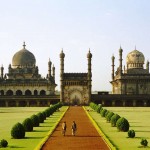 The Ibrahim-Rauza, built by Ibrahim ‘Adil Shah II (1580-1627), consists of his tomb and mosque within a square compound, both rising face to face from a common raised terrace, with a tank and fountain between them. The mosque has a rectangular prayer-chamber, with a facade of five arches, shaded by the chhajja and a slender minaret at each corner. Enclosed within a square fenestration rises the bulbous dome with a row of tall petals at its base. The square tomb with double aisles around it, the inner one pillared, has similar features but is finer in proportions. Two narrow arches, next to the ones at each end, break up its facade. On the interior, each wall has three arches, all panelled and embellished with floral, arabesque or inscriptional traceries. The tomb-chamber has a low curved ceiling made of joggled masonry, with empty space between it and the dome.
The Ibrahim-Rauza, built by Ibrahim ‘Adil Shah II (1580-1627), consists of his tomb and mosque within a square compound, both rising face to face from a common raised terrace, with a tank and fountain between them. The mosque has a rectangular prayer-chamber, with a facade of five arches, shaded by the chhajja and a slender minaret at each corner. Enclosed within a square fenestration rises the bulbous dome with a row of tall petals at its base. The square tomb with double aisles around it, the inner one pillared, has similar features but is finer in proportions. Two narrow arches, next to the ones at each end, break up its facade. On the interior, each wall has three arches, all panelled and embellished with floral, arabesque or inscriptional traceries. The tomb-chamber has a low curved ceiling made of joggled masonry, with empty space between it and the dome.
Uppali Burz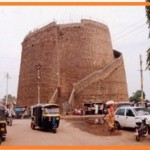
Built around 1584 by Hyder Khan, is an 80 ft (25 m) high tower standing to the north of Dakhani Idgah in Bijapur. This is a spherical structure with stone steps winding round the outside.
Sangeeta Mahal
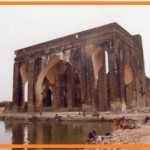 Located in Toravi , the ruins of a palace thought to be the royal court for music and dance; also the venue for the annual classical music concert – Navaraspur Music Festival (Jan-Feb)
Located in Toravi , the ruins of a palace thought to be the royal court for music and dance; also the venue for the annual classical music concert – Navaraspur Music Festival (Jan-Feb)
Taj Bawadi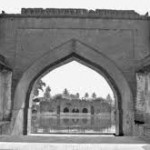
This great tank was built to commemorate Ibrahim II ‘s first wife Taj Sultana.Its front is a majestic arch flanked by 2 octagonal towers, the east & west wings of the towers form spacious rest houses.
Hazarat Khaja Ameenodeen Ali Ala Shere Khuda Chishti
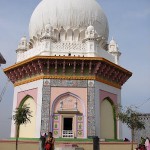 The kingdoms of the Bahamanis (1348-1527 C.E.) and the Adilshahis (1489-1686 C.E.) in the north of Karnataka and the interregnum of Hyder Ali and Tippu Sultan(1761-1799 C.E.) in Mysore were the major Islamic kingdoms in Karnataka. Bijapur flourished alongside the Mughal glory in the north. Masjids (mosques) big and small appeared in the newly conquered territories as if to match those built by the aesthete Mughal emperors.
The kingdoms of the Bahamanis (1348-1527 C.E.) and the Adilshahis (1489-1686 C.E.) in the north of Karnataka and the interregnum of Hyder Ali and Tippu Sultan(1761-1799 C.E.) in Mysore were the major Islamic kingdoms in Karnataka. Bijapur flourished alongside the Mughal glory in the north. Masjids (mosques) big and small appeared in the newly conquered territories as if to match those built by the aesthete Mughal emperors.
Asar Mahal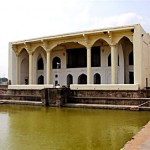
Asar Mahal also known as Asar-E-Sharif was constructed by Mohammad Adil Shah in 1646. It was built to serve as a ‘hall of justice’Three tanks grace the Mahal. The central square tank, 15 feet deep is fed by conduits from Begum tank. Two smaller and less deeper tanks are on either sides of the central large one.
It is believed to contain remnants of Prophet Muhammad. Two strands of Prophet Muhammad’s hair is also housed here.
Mehtar Mahal
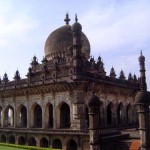 Mehtar Mahal, which literally mean a ‘Sweeper’s Palace’, is situated just a kilometer from Bijapur, in Karnataka. This ornamental gateway leading to a mosque and a garden is a fine example of the Indo-Saracenic style of architecture. It was built by a sweeper Ibrahim Adil Shah. Mehtar Mahal is embellished with a profusion of carvings in the form of stone brackets supporting the balconies and stone trellis work in Hindu style. The stone brackets are exquisitely garnished with carved birds and rows of swans.
Mehtar Mahal, which literally mean a ‘Sweeper’s Palace’, is situated just a kilometer from Bijapur, in Karnataka. This ornamental gateway leading to a mosque and a garden is a fine example of the Indo-Saracenic style of architecture. It was built by a sweeper Ibrahim Adil Shah. Mehtar Mahal is embellished with a profusion of carvings in the form of stone brackets supporting the balconies and stone trellis work in Hindu style. The stone brackets are exquisitely garnished with carved birds and rows of swans.
Jod Gumbad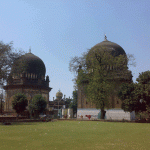
Jod Gumbad’s twin domed tombs were built in memory of Khan Muhammad and Abdul Razzaq Qadiri. The two were considered traitors as the general and the spiritual advisor helped the Mughal Emperor Aurangzeb defeat the young Adil Shahi ruler Sikandar. The structure was built in 1687 and is also known as Abdul Razzaq Dargah. The Dargah offers a spoon of holy water to all visitors. The reason why tombs for traitors was built and considered holy is unknown. The structure has beautiful bulbous domes and the garden in which these tombs are sited is a popular picnic spot.
Bara Kaman
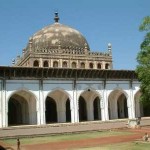 Bara Kaman is the unfinished mausoleum of Ali Adil Shah II in Bijapur, Karnataka in India. Ali Adil Shah of the Adil Shahi dynasty wanted to build a mausoleum of unmatched quality of architecture. As per the plan twelve arches will be placed vertically as well as horizontally surrounding the tomb of Ali Adil Shah. However due to unknown reason the work on the structure was left incomplete and only two arches were raised vertically. However still, the remains of the twelve arches placed horizontally can be seen.
Bara Kaman is the unfinished mausoleum of Ali Adil Shah II in Bijapur, Karnataka in India. Ali Adil Shah of the Adil Shahi dynasty wanted to build a mausoleum of unmatched quality of architecture. As per the plan twelve arches will be placed vertically as well as horizontally surrounding the tomb of Ali Adil Shah. However due to unknown reason the work on the structure was left incomplete and only two arches were raised vertically. However still, the remains of the twelve arches placed horizontally can be seen.
How To Reach Bijapur
By Air
The nearest airport to Bijapur is Belgaum, which is about 205 km away. Belgaum is connected to Mumbai by domestic flights. From Belgaum to Bijapur, taxi charge is about Rs 3500/-. Mumbai (486 km) and Bangalore (550 km) are the International Airports close by, from where it requires about 12 – 13 hours travel to reach Bijapur by Taxi/ buses.
By Train
Bijapur is connected by rail to many cities in the state and also the cities in the neighboring states. It is well connected to Bangalore, Mumbai, Hyderabad and Hubli.
By Bus
KSRTC buses are running regularly between the nearby cities to Bijapur. Tourist luxury buses are regularly available from Bangalore and Mumbai, each will cost about Rs 1200-1500 per head.
General Facts
State Karnatka
Population 3,26,360(2011)
Area 172 sq kms
Language Kannada,English,
Longitude 75° 43′ 12″ E
Latitude 16° 49′ 12″ N
Submit your review | |
